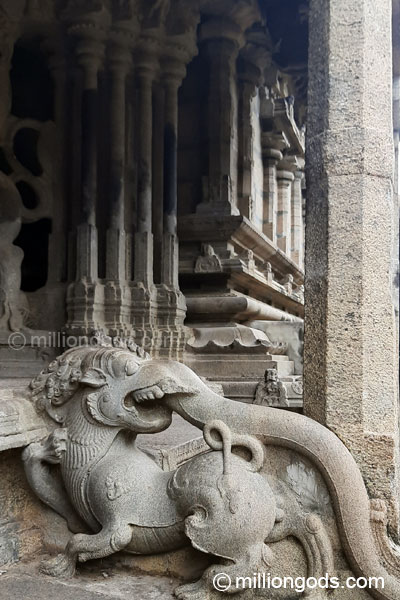Satyavagheeswarar, facing east
Satyavagheeswarar, Kalakkad

God
Goddess
Gomathi Ambal, facing east
Other Deities
Vinayaka, Muruga, Surya, Adhikara Nandi, Naalvar, Ayyappan with Poorna and Pushkala, Chithira Puthirar, Chandran, Navaneetha Krishnan, Juradevar, Saptha Maadar, 63 Nayanmar, Valampuri Vinayaka, Punnaivana Nathar, Thirupurasundari, Kasi Viswanathar, Visalakshi, Muruga with consorts, Nataraja, Sankara Lingam, Sankaranarayanar, Gajalakshmi, Annapoorani, Santhana Natarajar, Saneeswarar, Bhairava
Sanctum Sanctorum of main deity – Dakshinamurthy, Kalaimagal, Chandikeswara, Vinayaka, Navagraha
Satyavagheeswarar Kalakkad is a large east-facing temple with a 135 feet high, 9 tiered Rajagopuram at the eastern entrance. This is the tallest Gopuram in Tirunelveli District. The gopuram is preceded by a mandapam in front where there are shrines for Ganesha and Muruga on either side of the gopuram’s entrance. This huge Gopuram has about 200 mural paintings of Hindu Epics on the inside walls of the nine floors accessible through steps. These murals created around the 16th Century CE were in a state of neglect and were revived in recent times using the same kind of herbal colors originally used. The outer portion of the gopuram has more than 1500 stucco images.
There are 3 Prakarams here at Satyavagheeswarar Kalakkad. The outer Prakaram is large and has a lot of plants and trees. There is a small temple tank on the southeast side and a large south-facing Sekkizhar Mandapam on the northeast side with beautifully carved pillars. A brick Granary said to have been built during the 13th Century CE is also in this Prakaram. The next Prakaram has the Sanctum Sanctorum of Lord Satyavagheeswarar, the separate shrines of the Goddess and Navaneetha Krishna. The sides of the Prakaram have cloistered Mandapams. A total of 32 pillars in the Mani Mandapam is said to have been carved out of a single stone including the musical pillars. All the mandapams in this Prakaram including the Mahamandapams before the main deity and goddess have a large number of exquisite carvings on the pillars. Some of them are Vyagrapadar, Bhima battling Purushamirugam (Sphinx – human and animal combination), Cheraman Perumal with Sundarar, Yaali Pillars, King Udaya Marthanda Varma, and so many other ornamental carvings. In the Mandapam before the sanctum sanctorum are about 10 musical pillars. The inner roof and ceilings of this mandapam are unbelievably carved out of stone making them look like wood carvings. The Sanctum of the main deity has the innermost covered Prakaram which circumambulates around the sanctum.
As per Tamiraparani Mahatmayam (to be clarified) Satyavagheeswarar Kalakkad is considered as one of the Pancha (five) Aasana Sthalams, the others being Vazhudeeswarar (Erawadi), Nageswarar (Nanguneri), Manonmaneeswarar (Vijayaranyam), and Ramalingeswarar (Shenbagaramanallur).
Holy Water (Theertham) – Sathya Theertham
Sacred Tree (Sthala Vriksham) – Punnai (Calophyllum inophyllum)






History
Thirunavukkarasar (7th Century CE) has mentioned the lord of this temple in his hymns, making this a Vaippu Sthalam. There are many inscriptions in Satyavagheeswarar Kalakkad, particularly around the outer walls of the sanctum sanctorum. It has been understood that the temple dates back to the Pandyas of the 13th Century CE. During the Vijayanagar and Nayak periods (15-16th Century CE) most of the Mandapams and the excellent carvings were created. Inscriptions of the 15th Century CE refer to the place as Cholanattu Vallipuram and Vaanavan Naadu. The Venad ruler Vira Udaya Marthanda Varma (1516–1535 CE), whose image is carved in front of the Sanctum, made several contributions, and the musical pillars are attributed to him.
Legend
Satyavagheeswarar Kalakkad is associated with Ramayana. Sita is believed to have been abducted by Ravana from this area and hence it was known as Chorakaranyam in the ancient days. Rama and Lakshmana in their search for Sita are believed to have come here and were assured by Lord Shiva seated below a Punnai Tree that she would be found. After the victory over Ravana in Sri Lanka Lord Rama and Lakshmana came here to offer prayers to the Lord and hence he is known as Sathyavagheeswarar (one whose words are true). For the same reason, the pond inside the temple is called Sathya Theertham. Since the Lord was seated below a Punnai tree, he is also known as Punnaivana Nathar. In puranic days this place was also called Kantharpa Vanam.
Another legend is that Lord Shiva destroyed three Asuras and their impregnable forts through his smile and gave two of them the opportunity to be his dwarapalakas and one to play the drums during his dance. Sage Narada and Lord Vishnu are believed to have worshiped the lord here at Satyavagheeswarar Kalakkad to get back their eyesight that was lost as they made the three Asuras mentioned above to forget Lord Shiva’s worship.
Directions
Satyavagheeswarar Kalakkad is 14 kilometers west of Nanguneri and 20 kilometers south of Cheranmahadevi. The gopuram is visible from a distance.
Stay and Food
None locally except tea shops. The closest is Tirunelveli.
